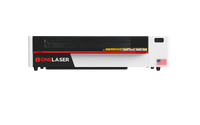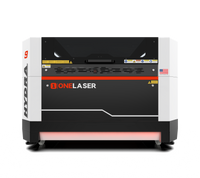Choosing the right laser engraving resolution isn't just about making images look sharp—it directly affects engraving speed, depth, material response, and the final surface finish. For many operators, resolution settings are chosen without much thought. This can lead to wasted time, subpar results, and avoidable wear on equipment.
Whether you're producing intricate graphics on acrylic or bold lettering on wood, understanding how to set the right resolution will help you achieve optimal results with maximum efficiency.
Key Takeaway
Laser engraving resolution directly impacts detail, speed, and material response. Higher DPI delivers fine detail for photos, logos, and intricate designs, while lower DPI improves efficiency and reduces heat effects for large or simple projects. Since each material reacts differently, the key is to balance resolution with material type and project goals—choosing the right setting ensures optimal quality without wasted time or equipment strain.

1. What Is Laser Engraving Resolution?
In laser engraving, resolution refers to the density of engraved points or lines on the material's surface.
- Definition: Typically measured in dots per inch (DPI) or lines per inch (LPI), this value represents how many laser pulses are fired within a given linear inch.
- Relation to Optics: The laser engraving machine resolution is limited by factors such as the beam's spot size, lens focal length, and the mechanical accuracy of the motion system. A high resolution laser engraving machine can produce extremely fine details, but only if the optics are well-calibrated.
- DPI vs. Image File Quality: Importing a 1200 DPI image into your software doesn't guarantee identical engraving clarity, your results are still capped by the machine's maximum resolution and the chosen settings.

How Resolution Affects Engraving Quality
The chosen DPI directly shapes the engraving's appearance, texture, and edge precision.
- High Resolution Laser Engraver Output: Produces fine edges, smooth gradients, and high-detail reproductions, perfect for photographs, intricate logos, and detailed artwork.
- Lower Resolution Settings: Reduce engraving time and minimize heat transfer, which is ideal for softer materials prone to burning or warping.
- Trade-offs: Higher resolution means more laser passes per inch, which increases job time, heat generation, and potential smoke buildup. Lower resolution speeds up production but sacrifices fine detail.
2. Material Considerations for Resolution Settings
Different materials react differently to laser engraving resolution because of variations in density, surface texture, and thermal conductivity.
Selecting the right DPI setting ensures detail quality while preventing heat-related damage, excessive run time, or material distortion.
2.1 Wood
Wood's organic grain and variable resin content cause uneven heat absorption. Using a very high DPI can result in deep burns, dark scorch marks, and even warping. A mid-range DPI (300–500) typically produces sharp details without overburning.
For fine text or photo engravings on hardwoods, a slightly higher DPI may be used with controlled power and speed adjustments.
2.2 Acrylic
Acrylic vaporizes cleanly under a laser, producing polished edges and detailed results at higher resolutions. Cast acrylic performs especially well at 500–1000 DPI, giving frosted or glass-like finishes. Higher DPI ensures crisp edges on intricate designs and prevents rough surfaces on small features.
2.3 Glass
Glass engraving depends on controlled micro-fracturing. A higher DPI (400–600) results in a smoother frosted effect, while too low a DPI can make the engraving appear grainy or pitted. Excessively high DPI combined with high power can cause unwanted chipping or spalling, especially along edges.

2.4 Coated Metals
Anodized aluminum, powder-coated steel, and painted metals require fine resolution to remove coatings precisely without damaging the substrate. A high DPI (600–1000) is often necessary for crisp lettering, logos, and intricate patterns. Lower DPI may leave coating remnants, reducing clarity.

Recommended Laser Engraving Resolution by Material
| Material | Recommended DPI Range | Main Benefits at This DPI |
Risks if Too High/Low
|
| Wood | 300–500 | Clean edges, minimal charring, natural tone |
Too high: overburning, warping; Too low: loss of detail
|
| Acrylic | 500–1000 | Polished edges, high detail, smooth fills |
Too high: increased run time; Too low: rough edges
|
| Glass | 400–600 | Smooth, frosted effect, minimal chipping |
Too high: edge spalling; Too low: coarse finish
|
| Coated Metals | 600–1000 | Crisp text/logos, precise coating removal |
Too high: excessive coating removal; Too low: jagged/incomplete marks
|
3. When to Use High Resolution vs. Low Resolution
Selecting the correct laser engraving resolution is a balance between visual fidelity and operational efficiency. While a high resolution laser engraver can produce breathtaking detail, it is not always the most practical choice for every application.
Resolution directly affects run time, heat buildup, and production costs. Understanding when to prioritize detail over speed—and vice versa—ensures consistent quality without sacrificing productivity.
3.1 High Resolution Laser Engraver Use Cases
High DPI settings (typically 600–1200 DPI) are best suited for applications where microscopic accuracy and fine detail are critical. These jobs often justify the longer processing time due to the value of the final product.
- Photo Engravings with Smooth Tonal Gradients: High resolution allows for accurate halftone rendering, enabling smooth shading and nuanced grayscale reproduction. Essential for portrait work, memorial plaques, and artistic engravings.
- Fine Text and Micro-Scale Patterns: Small fonts, intricate logos, and detailed vector art require tight dot placement to maintain legibility and sharpness, especially under magnification.
- High-End Personalization Projects: Luxury branding, awards, and custom gifts benefit from flawless edges and consistent texture, attributes achievable only with higher DPI on a high resolution laser engraving machine.
Explore Our High-Resolution Laser Engravers!
3.2 Low Resolution Settings
Lower DPI settings (150–400 DPI) trade microscopic precision for faster processing and reduced thermal stress on materials.
- Large-Scale Signage and Bold Shapes: Broad lettering and simple vector art do not require extreme detail, allowing for faster runs without sacrificing visual impact.
- Cutting-Focused Jobs: When the primary goal is cutting rather than engraving, a lower DPI ensures minimal engraving time, leaving more machine time for cutting passes.
- Speed- and Cost-Sensitive Production: Lower DPI reduces pass density, cutting processing time and operational costs—ideal for bulk orders where throughput matters more than minute detail.
3.3 Speed vs. Detail Balance
While a high resolution laser engraving machine is capable of fine, artistic results, overusing maximum DPI on every project can be counterproductive. Each increase in resolution dramatically increases the number of laser pulses per inch, which in turn:
- Increases processing time, sometimes doubling or tripling run length.
- Increases material heating, which may cause warping, melting, or burn marks.
- Contributes to faster optical and mechanical wear on the system.
For many vector-based or large-format designs, a moderate DPI (300–500) provides a visually clean result while keeping production efficient. The key is matching resolution to the visual needs of the design—not just using the highest setting available.
4. Common Mistakes in Choosing Resolution
- Defaulting to Maximum DPI: Leads to unnecessary slowdowns and potential overheating.
- Ignoring Material Reaction: Each material's optimal DPI varies; a setting that works for acrylic may ruin wood or leather.
- Overestimating Machine Capability: Even a high resolution laser engraving machine has optical and mechanical limits.
5. FAQs
Q1: Does higher resolution always mean better quality?
Not necessarily—some materials actually look cleaner at moderate DPI due to reduced heat effects.
Q2: How does resolution affect engraving depth?
Higher DPI generally increases depth slightly due to more overlapping laser pulses, but depth is primarily controlled by power and speed.
Q3: Can I use the same resolution for all materials?
It's not recommended; each material reacts differently to laser heat and density.
Q4: Does lens type affect usable resolution?
Yes, smaller focal length lenses can produce finer detail at high resolution, while longer lenses are better for larger engravings.
Have Questions? Join Our Forum!
Conclusion
The correct laser engraving resolution is a balance between detail, material compatibility, and production efficiency. Understanding when to use the capabilities of a high resolution laser engraver and when to optimize for speed can significantly improve both quality and profitability.
By testing, recording results, and making informed adjustments, you'll ensure every engraving meets your quality standards without unnecessary waste of time or resources.

 Liquid error (sections/image-banner line 171): invalid url input
Liquid error (sections/image-banner line 171): invalid url input






